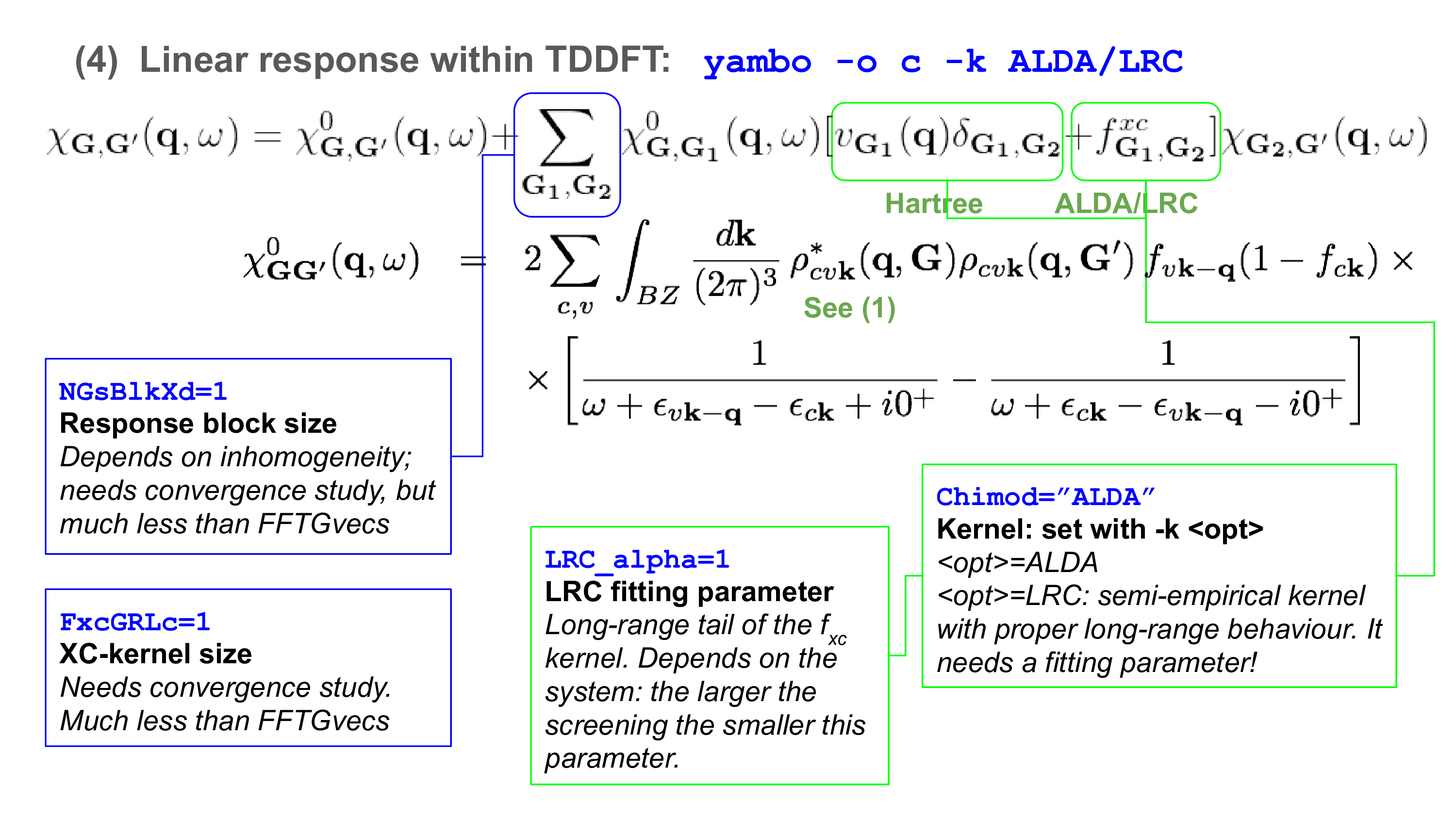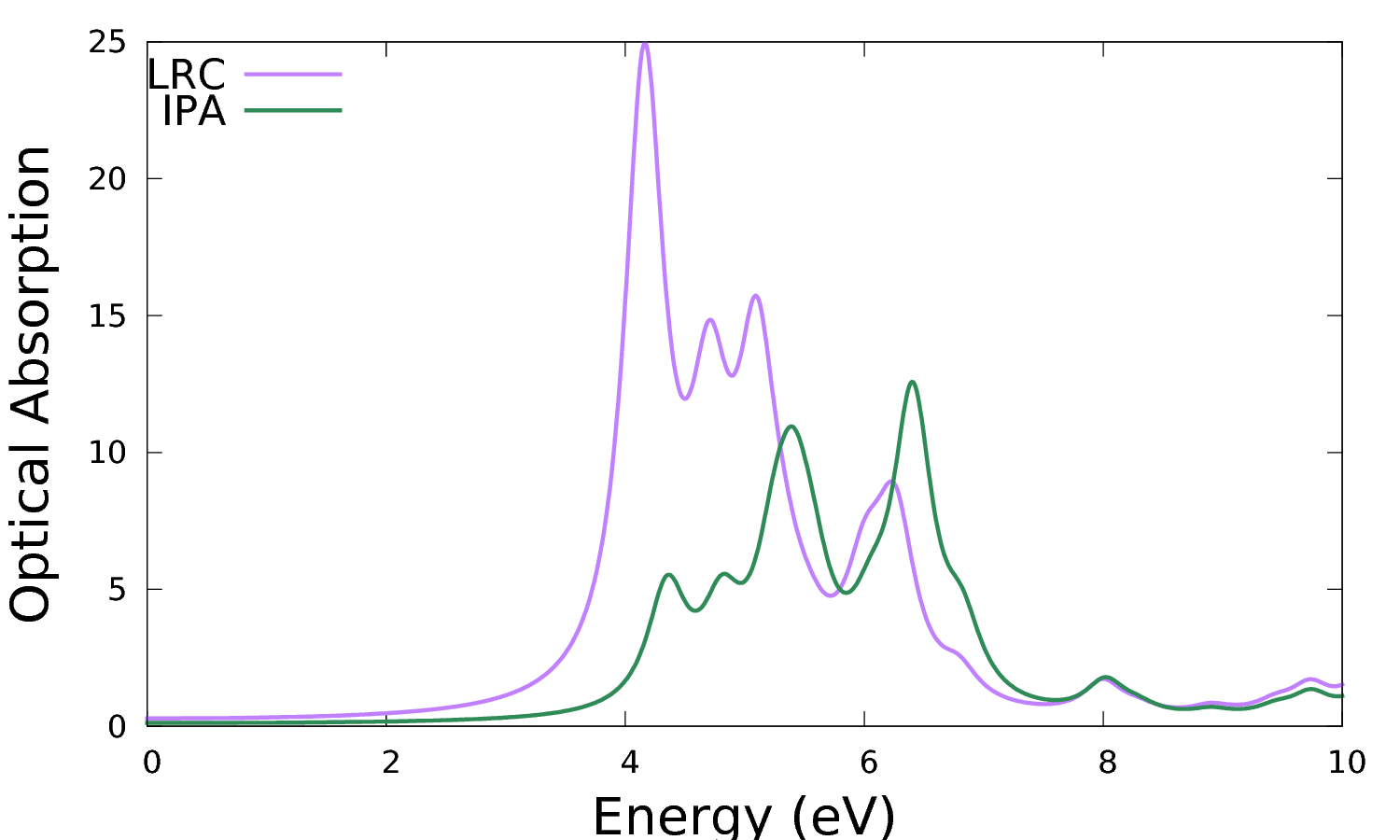Time-dependent density functional theory (long-range corrected kernel)
Similarly to previous module you will calculate optical spectra at the time-dependent density-functional theory level for bulk hBN. At difference with the previous module you will use an xc kernel which has the correct long range behavior.
Background
Let's recall the Dyson equation for the susceptibility X within the time-dependent DFT formalism in reciprocal space:
The f xc term is called the exchange-correlation (xc) kernel and describes the response of the xc potential at a time t to changes in the density at all previous times. In the previous module we have looked at approximations for the xc kernel that can be derived by taking the functional derivative of common approximations for the xc potential with respect to the density, such as the adiabatic local density approximation (ALDA). Results from the previous module showed that for bulk hBN the latter approximation provides spectra similar to the RPA/IPA. This trend is common to optical absorption spectra of extended systems.
One of the main problems that has been pinpointed in the literature is that ALDA and its likes miss a long range contribution which is essential to reproduce excitations in solids. Several approximations have been proposed to introduce this essential long range contribution.[1][2][3][4][5]
Within this family we consider here the long-range correction approximation (LRC):
where α is a system dependent empirical parameter related to the dielectric screening.[6]
Note that approximations of this form cannot be rigorously justified within the sole time-dependent density-functional framework. Additional key quantities such as the electron density current or the macroscopic polarization (together with the corresponding xc fields) need to be considered.[7][8][9]
Prerequisites
- You must first complete the "How to use Yambo" and the "Optics at the independent particle level" and "local fields" modules
You will need:
- The
SAVEdatabases for bulk hBN - The
yamboexecutable gnuplot, for plotting spectra
Choosing input parameters
Enter the folder for bulk hBN that contains the SAVE directory, and generate the input file. From yambo -H you should understand that the correct option is yambo -o c -k <opt> .
Where <opt> can be 'hartree' as in the tutorial on the local fields, or 'alda' as in the previous tutorial or 'lrc' respectively for the ALDA and LRC approximations for the xc kernel.
Let's start by generating the input for a claulcation wit the LRC kernel:
$ cd YAMBO_TUTORIALS/hBN-3D/YAMBO $ yambo (Initialization) $ yambo -F yambo.in_LRC -J 3D_LRC -o c -k lrc
We thus use a new input file yambo.in_LRC and label all outputs/databases with a 3D_LRC tag. Make sure to set/modify all of the following variables to:
Chimod= "LRC" # [X] IP/Hartree/ALDA/LRC/BSfxc LRC_alpha= -1.200000 # [TDDFT] LRC alpha factor NGsBlkXd= 3 Ry # [Xd] Response block size % QpntsRXd 1 | 1 | # [Xd] Transferred momenta % % EnRngeXd 0.00000 | 10.00000 | eV # [Xd] Energy range % % DmRngeXd 0.200000 | 0.200000 | eV # [Xd] Damping range % ETStpsXd= 1001 # [Xd] Total Energy steps % LongDrXd 1.000000 | 1.000000 | 0.000000 | # [Xd] [cc] Electric Field %
In this input file, we have selected:
- the long-wavelength limit q = 0 (optical limit)
- A q parallel to the BN planes
- The LRC kernel with the semi-empirical real parameter α = -1.2 and expanded G-vectors in the screening up to 3 Ry (about 85 G-vectors)
Optics runlevel
Save the input file and launch the code, keeping the command line options as before (i.e., just remove the lower case options):
$ yambo -F yambo.in_LRC -J 3D_LRC
You can compare the absorption with LRC and at the independent particle level (IPA). By inspecting the o-3D_LRC.eps_q1_inv_LRC_dyson file we find that this information is given in the 2nd and 4th columns, respectively:
$ head -n30 o-3D_LRC.eps_q1_inv_lrc_dyson
- Absorption @ Q(1) [q->0 direction] : 0.7071068 0.7071068 0.0000000
- E/ev[1] EPS-Im[2] EPS-Re[3] EPSo-Im[4] EPSo-Re[5]
Plot the result:
$ gnuplot gnuplot> plot "o-3D_LRC.eps_q1_inv_lrc_dyson" u 1:2 w l t 'LRC',"o-3D_LRC.eps_q1_inv_lrc_dyson" u 1:4 w l t 'IPA'
Note that:
- the spectrum onset is red-shifted
- the intensity of some of the peaks is enhanced
The effect is analogous to the Bethe-Salpeter kernel at the same computational cost of an RPA calculation of the optical spectrum. For a link between the two methods see for example Reining et al.[10].
The main problems of this approximation are
- the choice of the α parameter
- in wide-band gap insulator α can be fitted to reproduce just the first peak.
A thorough discussion on those points is given for example in [Sottile's PhD thesis ]. Look at the References for more (recent/sophisticated) long-range corrected approximations to the kernel.
Summary
From this tutorial you've learned:
- How to compute an optical spectrum within time-dependent density functional theory with a long-range corrected kernel.
Links
- Previous module: ALDA kernel
- Related: Bethe-Salpeter equation tutorial
- Related: First steps with yambo tutorial
- Back to tutorials menu
References
- ↑ L. Reining, V. Olevano, A. Rubio, and G. Onida, Phys. Rev. Lett. 88, 066404 (2002)
- ↑ P. E. Trevisanutto, A. Terentjevs, L. A. Constantin, V. Olevano, and F. Della Sala, Physical Review B 87, 205143 (2013)
- ↑ J. A. Berger, Phys. Rev. Lett. 115, 137402 (2015)
- ↑ S. Rigamonti, S. Botti, V. Veniard, C. Draxl, L. Reining, and F. Sottile, Phys. Rev. Lett. 114, 146402 (2015)
- ↑ S. Sharma, J. K. Dewhurst, A. Sanna, and E. K. U. Gross, Phys. Rev. Lett. 107, 186401 (2011)
- ↑ S. Botti, F. Sottile, N. Vast, V. Olevano, L. Reining, H.-C.Weissker, A. Rubio, G. Onida, R. Del Sole, and R. Godby, Physical Review B 69, 155112 (2004)
- ↑ M. Gr¨ning, D. Sangalli, C. Attaccalite, C. Physical Review B 94, 035149 (2016)
- ↑ P. L. de Boeij, F. Kootstra, J. A. Berger, R. van Leeuwen, and J. G. Snijders, The Journal of Chemical Physics 115, 1995 (2001)
- ↑ J. A. Berger, Phys. Rev. Lett. 115, 137402 (2015)
- ↑ L. Reining, V. Olevano, A. Rubio, and G. Onida, Phys. Rev. Lett. 88, 066404 (2002)


